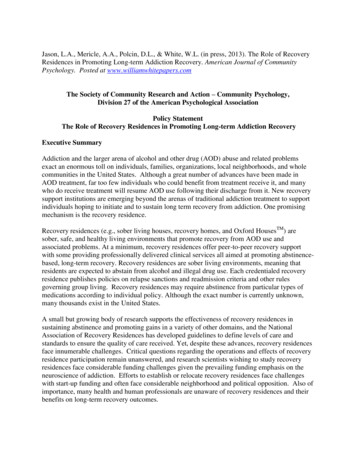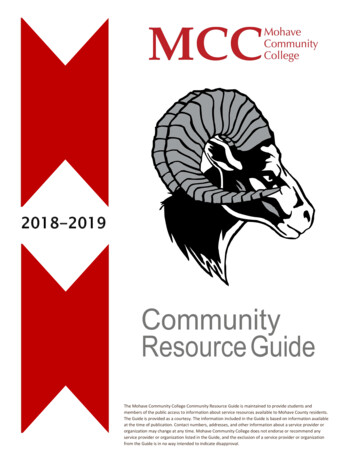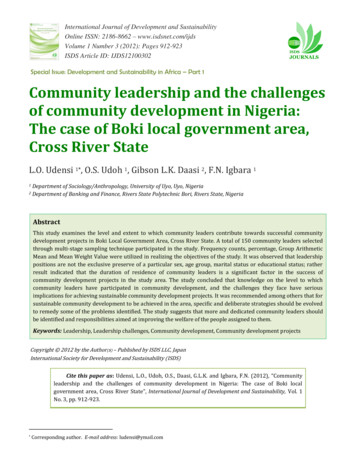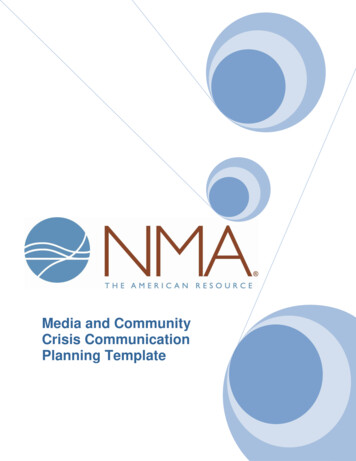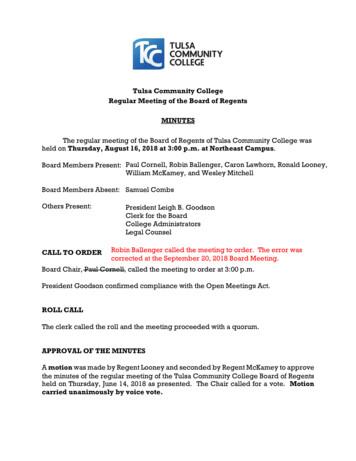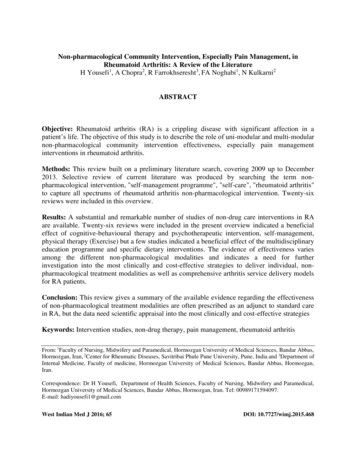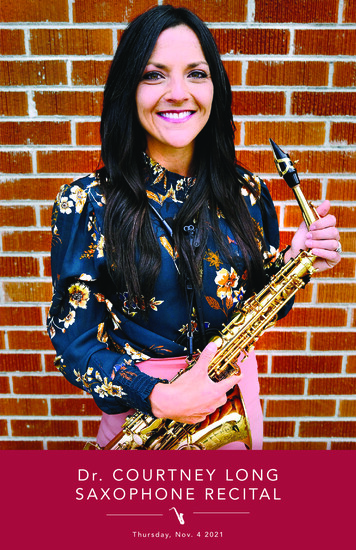
Transcription
D r. C O U R T N E Y L O N GS A X O P H O N E R E C I TA LT h u r s d a y, N o v. 4 2 0 2 1
PROGRAMCaprice en forme de valse . Paul Bonneau (1918-1995)Tableaux de Provence . Paul Maurice (1910-1967)I. Farandoulo di ChatounoII. Chanson pour ma MioIII. La BohémienneIV. Des Alyscamps l'ame SoupireV. Le CabridanBrilliance. Ida Gotkovsky (b. 1933)I. DéclaméII. DesinvolteIII. DolcissimoIV. FinalINTERMISSIONKuKu.Barry Cockcroft (b. 1972)Sonata for Eb saxophone and piano Opus 19 . Paul Creston (1910-1967)I. With vigorII. With tranquilityIII. With gaietyTwo Preludes.Dorothy Chang (b. 1970I. Adagio e espressivoII. Prestissimo
NOTESCaprice en forme de valsePaul Bonneau (1918-1995) is known for his French film compositions, and his extensivework as a conductor in recording sessions and concerts broadcast on national radiostations. Bonneau composed this short work in 1950 for Marcel Mule, and it remainsone of the most standard pieces for unaccompanied saxophone in the repertoire. It isa virtuosic caricature of the Viennese waltz that exists in continuous variation; thelistener is challenged to listen for the simple melody in 3/8 meter that exists below theextensive rubato and decoration. Musical comedic gestures abound as each phraseleads to an unexpected place.Tableaux de ProvencePaule Maurice (1910-1967) composed Tableaux de Provence in 1956, which is afive-movement programmatic suite, for important saxophone pedagogue MarcelMule, when they both taught at the Paris Conservatory. This work describes theculture of Provence in southeast France, painting pictures of where she and herhusband, fellow composer Jean Lantier, spent every summer. Though not much isknown of Maurice, letters she wrote to performers about the work have surfaced,which provide valuable insight.I. “Farandoulo di Chatouno” (Dance of the Young Girls) is written in the hypolydianmode. It expresses joys of youth and celebrates the rhythmic Provencal round dance,the Farandole. The saxophone and piano share interspersed dialogue.II. “Chanson pour ma Mio” (Song for my Beloved) opens with notes based on guitartuning pitches. The saxophone then introduces a tender and poetic phrase over thepiano’s motion that is reminiscent of a serenade.III. In “La Bohémienne” (The Bohemian Girl), a strongly emphasized rhythm and drivingmotion expresses the fiery temperament and conviction of people who go on apilgrimage to Saintes-Maries-de-la Mer.IV. “Des Alyscamps l'ame Soupire” (From the Graveyard Souls Sigh): The saxophonesings a plaintive, nostalgic melody. This piece is constructed on the form of a lied andwas composed as Maurice was grieving the loss of a dear family member. It is full ofsadness and nostalgia.V. “Le Cabridan” (The Bumblebee) is a large, buzzing insect native to the Provenceregion. The saxophone’s agility is well-suited for presenting the rapid and swirlingagitated figures found in this piece. It is written with perpetual motion which is brieflyinterrupted by a short cadenza. The reprise of the theme, played in canon by thesoloist and the piano, seems to depict the rapid escape of the insect at the closing,disappearing with a sudden diminuendo.
BrillanceIda Gotkovsky (b. 1933) admits to “loving without reservation or prejudice all types ofmusic, provided that it has great depth and knows how to be the interpreter of thegreater inspirations of mankind.” She studied composition under Nadia Boulangerand Olivier Messian. She is currently a professor of music theory at the ParisConservatory. She composed Brillance in 1974, and, according to Gotkovsky, thisfour-movement piece expresses passion, emotion, force of power, tenderness, anddelicateness through impressionistically influenced writing and much virtuosity forboth performers. She has composed other important works for saxophone, namelyQuatour de Saxophone, Concerto for Saxophone and Orchestra, and VariationsPathetiques. She is quoted as stating that “the saxophone is an admirable instrument,a source of prolific inspiration with dazzling possibilities.”I. “Déclamé” is written with free rhythms and recitative writing, creating animprovisatory style that explores the extremes of dynamic possibility.II. “Desinvolte” is in a quickly articulated, dance-like style that includes the note “withhumor.”III. “Dolcissimo” returns to the improvisatory quality of the first movement, but withmore tenderness.IV. “Final” incorporates much forward motion and drive, with virtuosic, impetuousdialogue between the piano and saxophone, and is described by Gotkovsky asculminating in “strength and joy.”Ku KuAustralian composer and saxophonist, Barry Cockcroft (b. 1972), composed Ku Ku in1997 for solo soprano saxophone. He was influenced by Luciano Berio’sSequenza VII; the idea for this piece came from improvising around Sequenza’sthemes, and from playing funky rhythms with Berio’s multiphonics. Iteventually grew into this programmatic piece, which is in two main sections.It begins with long, lyrical lines and minimalistic “loops,” and progresses intodriving rhythms with techniques such as slap tonguing and multiphonics todepict a chicken.Kuku in Swahili means chicken.Ku-ku is a type of clock made in the Black forest.Ku Ku means crazy.There are happy hens, ones that live on an organic farm,that have worms to eat and lay lots of eggs.The air is fresh and the handsome rooster caters for all their needs There are other kinds of chickens,ones that may have lost their mind, or their head!Each day they do the same thing, they live in little boxes,cluck, cluck .cluck, cluck.-Barry Cockcroft program notes
Sonata for Eb alto saxophone and piano Opus 19Born Guiseppe Guttoveggio in New York City to Sicilian immigrants, Paul Creston(1906-1985) adopted his professional name from his favorite saint and a character heonce portrayed in a play. Rhythm is central to Creston's musical aesthetic, and hewrote two academic books on the subject. He composed the Sonata for Eb altosaxophone and piano for the American virtuoso Cecil Leeson in 1939, and it quicklybecame an important part of classical saxophone repertoire, bridging the gapbetween tonal and post-tonal music with his richly chromatic, uniquely jazz-inspiredharmonic idiom. The three strikingly different movements are held together byfragments of melodic motives that are always presented within new harmonicframework.I. “With vigor”: The main theme is presented right away with its pointed sixteenthnote figure that is later balanced with the long, legato phrases of the second theme.II. “With tranquility”: Creston generates a sense of timelessness in this movement withits 5/4 meter, long lines, and its opposition of duple against triple in both instruments.III. “With gaiety”: Crisp and precise, this last movement touts metric displacement tocreate a light, quasi-rhumba dance rhythm that is varied throughout.Two PreludesDescribed as "evocative and kaleidoscopic” (Seattle Times), the music of DorothyChang (b. 1970) has been praised for its colorful and often impressionistic scoring, aswell as for its dramatic intensity and expressive lyricism. Her music is rooted in theWestern art music tradition but often reflects the eclectic mix of musical influencesfrom her youth, ranging from marching band to traditional Chinese music. Chang’sTwo Preludes was written in 1993 for saxophonist Christopher Creviston. The twomovements were originally conceived as short movements to precede an intendedlonger work for saxophone and piano. The larger work was never written, and thepreludes now stand as a complete work on their own. The movements are contrastingin character, written to highlight the range of expression possible with the saxophoneand piano.I. “Adagio e espressivo” is very gentle and lyrical with an emphasis on creating a senseof spaciousness and transparency. The saxophone melody, supported by a sparsepiano accompaniment, unfolds slowly and has a very free and almost improvisatoryfeel.II. The composer’s intention for “Prestissimo” was to create a feeling of reckless,driving energy. The music is aggressive yet exuberant, marked by lightning-fastvirtuosic passages in both instruments and constant shifts of the rhythmic pulse.-Dorothy Chang program notes
THANKSFOR COMING!Contributions like yours is what keeps our programsrunning at the quality we proudly maintain. Won’t youconsider a donation via the following convenient methods:PayPal: friends.edu/paypalJoin: Friends of Fine Arts: friends.edu/givefineartsMail: Friends University Fine Arts2100 W. University Ave.Wichita, KS 67213J O I N U S AT A N O T H E R E V E N T !More info and full calendar at friends.edu/fineartsticketsFriends University Berean Academy Band ConcertMonday, Nov. 8, 7:30 p.m.Sebits AuditoriumFriends University Chamber OrchestraThursday, Nov. 11, 7:30 p.m.Casado Campus CenterLittle Women (fall musical)Friday, Nov. 19, 7:30 p.m.Saturday, Nov. 20, 7:30 p.m.Sunday, Nov. 21, 2 p.m.Sebits AuditoriumChristmas CandlelightFriday, Dec. 3, 7:30 p.m.Saturday, Dec. 4, 2 p.m.Central Community Church2100 W. University Ave. Wichita, KS 67213 friends.edu/fineartsAccredited by the Higher Learning Commission and a member of theNorth Central Association, 230 S. LaSalle Street, Suite 7-500, Chicago, IL 60604; www.ncahlc.org; 1-800-621-7440.
Dr. Lillian Green, Conductor 11.2.21 PROGRAM. . IV. “Des Alyscamps l'ame Soupire” (From the Graveyard Souls Sigh): The saxophone sings a plaintive, nostalgic melody. This piece is constructed on the form of a lied and . I. “Adagio e espressivo” is very gentle and lyrical wit

